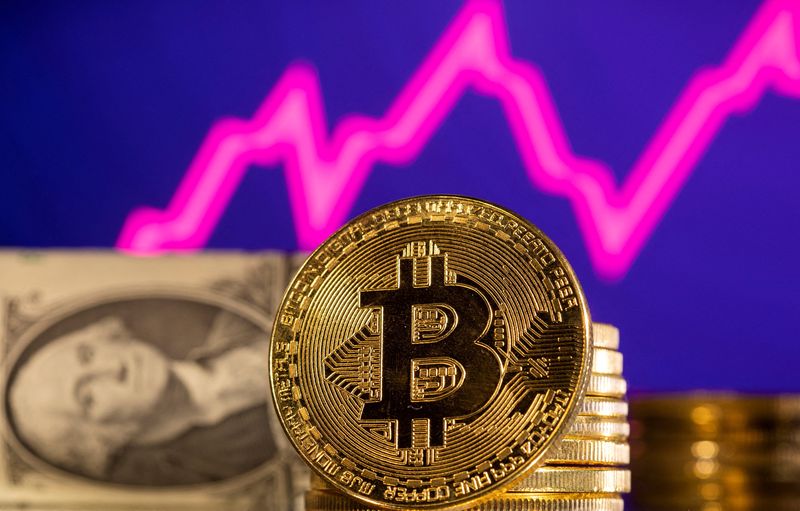By Hannah Lang and Suzanne McGee
(Reuters) – As traditional institutions pour money into bitcoin, the cryptocurrency’s latest meteoric rally to a record high may have more legs than in 2021, experts say.
The world’s largest cryptocurrency, notorious for its volatility, touched $69,202 on Tuesday, driven by excitement over new U.S. spot bitcoin exchange-traded funds (ETFs) and expectations the Federal Reserve will begin cutting U.S. interest rates this year.
Since bitcoin has less than two decades as a financial asset, predicting its price trajectory remains extremely challenging. Just months after retail exuberance helped drive bitcoin to its previous record in November 2021 the cryptocurrency crashed, taking half the crypto industry with it.
But more institutions committing long-term money could help the token sustain its high levels this time around, analysts and executives said.
“Traditional institutions were once sitting out; today, they are here in full force as the principal drivers of the crypto bull market,” said Nathan McCauley, CEO of Anchorage Digital, a crypto platform.
In February, for example, software firm MicroStrategy said it had bought about 3,000 bitcoins for $155 million, while social media platform Reddit disclosed it had bought small amounts of bitcoin and ether.
“The market is getting pushed around by some of the crypto industry whales,” said Steve Sosnick, chief strategist at Interactive Brokers, adding he expected a short-term pullback in bitcoin’s price as investors take profits.
Another driver of sticky money are 10 new U.S. bitcoin ETFs, which provide a regulated option for traditional institutions or other buyers who may now feel safer investing in the cryptocurrency.
Bitcoin has jumped more than 50% this year alone, with most of those gains coinciding with inflows into the new ETFs. Net flows into the products reached $7.9 billion as of Monday, according to BitMex Research.
Sui Chung, CEO of CF Benchmarks, which is providing the index for six of the ETF, said he knew of some registered investment advisors and other big institutions that were buying into the ETFs, although he declined to name them.
“For institutions, bitcoin’s core appeal is the diversification potential it offers,” he added.
Wealth manager Gerber Kawasaki has invested in BlackRock’s spot bitcoin ETF via its AdvisorShares ETF, crypto outlet The Block reported last month. Such investors are typically less price sensitive, Bitfinex analysts wrote.
“Any decline following the top of the current cycle could be less drastic than previous downturns. We saw a similar stable trajectory in price after a huge increase following the launch of gold ETFs,” they added.
Indicators that other analysts have used to gauge retail interest in cryptocurrencies, like Google searches, have remained muted compared to 2021 and 2022, according to Google trends.
Trading in CME Micro Bitcoin futures, which at 1/10th of a bitcoin are affordable to wealthier retail investors, jumped from 32,007 on Feb. 27 to nearly 87,000 on Feb. 28, CME data shows.
“If there is a retail frenzy, it started on Feb. 27th,” said Chung.
SUPPLY DYNAMICS
To be sure, Bitcoin just came into existence in 2008 and remains a speculative asset dominated by retail investors. Its short track record makes it hard to predict how it will trade over multiple economic cycles.
In contrast to commodities like gold, it has no economic fundamentals, so there is no reliable way to forecast its price, European Central Bank analysts warned last month.
Still, as with commodities, supply factors are at play.
One unknown is the potential price overhang from bitcoins trapped in bankruptcies that could be liquidated in coming months. As much as $35 billion worth of crypto was locked up in bankruptcies last year, although Reuters could not ascertain how much was in bitcoin.
On the other hand, the upcoming bitcoin “halving” is set to further reduce supply, ultimately capped at 21 million bitcoins. That process last occurred in 2020, meaning there is more pressure on bitcoin’s supply compared to the rally in 2021.
That could push prices higher, said Zach Pandl, managing director of research at Grayscale Investments, which operates one of the spot bitcoin ETFs.
“Bitcoin demand is colliding with increasingly tight supply,” he added.
(Reporting by Hannah Lang in Washington and Suzanne McGee; additional reporting by Elizabeth Howcroft in London; editing by Michelle Price and David Gregorio)
This article was originally published by a finance.yahoo.com . Read the Original article here. .

